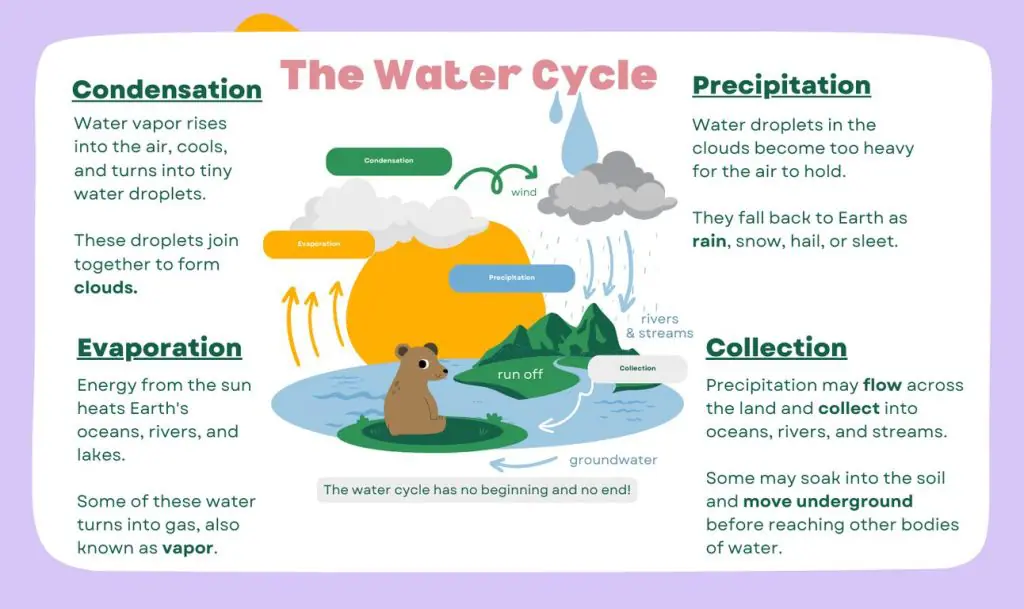What is the Water Cycle? – Explanation & Experiments
Introduction
Understanding Rain and the Water Cycle
Rain is a natural phenomenon that is intricately linked to the water cycle, a continuous process that regulates the distribution of water on Earth. Let’s delve into the science behind rain and explore its connection to the water cycle.
Analogy of Definition
The Water Cycle Explained
The water cycle, also known as the hydrologic cycle, encompasses the processes of evaporation, condensation, and precipitation that occur to maintain the Earth’s water balance. Rain is a direct result of the water cycle, serving as a vital component of this natural process.
The water cycle is like a big, magical loop that keeps water moving around our Earth. Let’s follow a drop of water on its amazing journey.
1. Evaporation
Imagine you’re outside on a sunny day. The sun shines down and warms everything up. When the sun’s heat warms up rivers, lakes, and oceans, the water starts to change. It turns into a gas called water vapor. This process is called evaporation. It’s like when you see steam rising from a hot pot of water.
2. Condensation
As the water vapor rises up into the sky, it gets cooler. When it gets cool enough, it changes back into tiny drops of water. This is called condensation. These tiny drops come together to form clouds. So, clouds are really just made up of lots of little water drops!
3. Precipitation
Now, the clouds are floating around, full of water drops. When the clouds get too heavy with all that water, the drops fall back down to Earth. This falling water is what we call precipitation. Precipitation can be rain, snow, sleet, or hail, depending on the temperature. If it’s warm, we get rain. If it’s cold, we might get snow.
4. Collection
Once the water falls to the ground, it needs to go somewhere. It collects in rivers, lakes, and oceans. Some of it soaks into the ground and becomes part of the underground water supply. Plants and trees also drink up some of this water to grow.
Back to the Start
After the water collects, the sun comes out again, and the whole cycle starts over. Water evaporates, forms clouds, falls as precipitation, and collects again. It’s a never-ending cycle that keeps our planet full of the water we need to live!

Method
The Importance of Water Cycle
The water cycle is incredibly important for many reasons. Let’s explore why this magical process is essential for life on Earth:
1. Provides Fresh Water: The water cycle is nature’s way of recycling water. It ensures that we have a constant supply of fresh water to drink, cook with, and use in our daily lives. Without the water cycle, we would run out of clean water very quickly!
2. Helps Plants Grow: Plants need water to grow. Through precipitation, the water cycle delivers the necessary water to plants, helping them to flourish. This is essential for producing the food we eat, the oxygen we breathe, and maintaining the natural beauty of our environment.
3. Regulates Weather and Climate: The water cycle plays a crucial role in regulating the Earth’s weather and climate. The process of evaporation and condensation helps to distribute heat around the globe, influencing weather patterns and keeping our planet’s temperature balanced.
4. Supports All Living Things: Every living thing, from tiny insects to giant whales, depends on water to survive. The water cycle ensures that water is available to all forms of life, providing habitats for animals and helping ecosystems thrive.
5. Cleans and Filters Water: As water moves through the cycle, it goes through natural filtration processes. When water evaporates, it leaves impurities behind, and when it seeps through the ground, it gets filtered by soil and rocks. This natural cleaning process is vital for maintaining the purity of our water sources.
6. Recharges Groundwater: The water cycle helps to refill underground water reserves, known as aquifers. These underground reservoirs are essential for providing water during dry periods and are a crucial resource for agriculture, industry, and everyday use.
7. Drives the Earth’s Systems: The water cycle is interconnected with other natural cycles, like the carbon cycle and nitrogen cycle. It helps to drive these systems, ensuring that nutrients are cycled through the environment, supporting life and maintaining the health of our planet.
Examples
Example: Make a Water Cycle in a Bag:
Materials: Ziploc bag, water, blue food coloring, a permanent marker, tape.
Steps:
- Draw a sun, clouds, and waves on the outside of the bag with the marker.
- Fill the bag with a small amount of water and add a few drops of blue food coloring.
- Seal the bag tightly and tape it to a sunny window.
- Observe over a few days as the water evaporates, condenses on the sides of the bag, and then “rains” back down.
Quiz
Tips and Tricks
1. Create a Miniature Rain Cloud: Materials: A clear jar, water, shaving cream, blue food coloring, a dropper.
Steps:
- Fill the jar with water, leaving some space at the top.
- Spray shaving cream on the surface of the water to create a “cloud.”
- Use a dropper to add blue food coloring to the shaving cream.
- Watch as the “rain” falls from the shaving cream cloud into the water below.
2. Water Cycle Wheel Craft: Materials: Printable water cycle wheel template, scissors, paper fastener, markers or crayons.
Steps:
- Print out a water cycle wheel template (available online).
- Color and cut out the pieces of the wheel.
- Attach the pieces together using a paper fastener in the center.
- Spin the wheel to see the different stages of the water cycle.
3. Evaporation Experiment: Materials: Two identical bowls, water, a sunny spot, a marker.
Steps:
- Fill both bowls with the same amount of water.
- Place one bowl in a sunny spot and the other in a shady spot.
- Mark the water level in each bowl with a marker.
- Check the water levels over several days to see which one evaporates faster.
4. Rain Gauge Craft: Materials: A clear plastic bottle, scissors, ruler, permanent marker, stones or gravel.
Steps:
- Cut the top off a clear plastic bottle.
- Place stones or gravel in the bottom of the bottle to keep it stable.
- Use a ruler and marker to mark measurements on the side of the bottle.
- Place the bottle outside when it’s raining and measure the amount of rainfall.
Real life application
Story: The Adventure of Raindrop and the Water Cycle
Raindrop, a curious water droplet, embarks on a journey through the water cycle, encountering various stages such as evaporation, condensation, and precipitation. Along the way, Raindrop learns about the vital role of rain in sustaining life on Earth and replenishing the planet’s water sources.
FAQ's
Like? Share it with your friends






